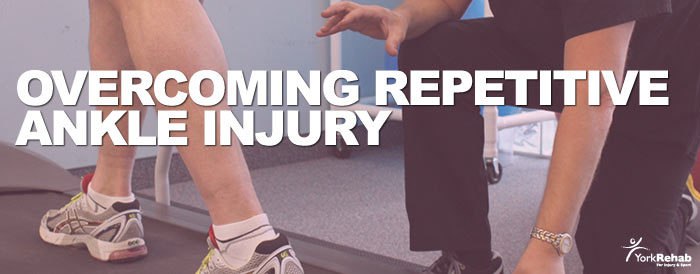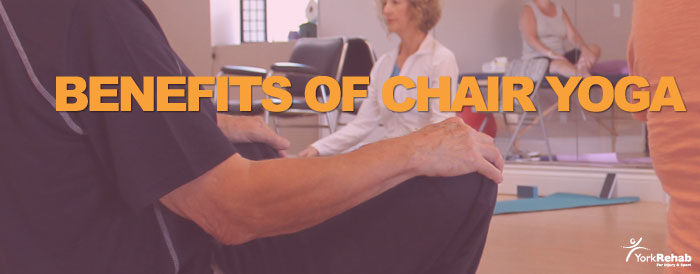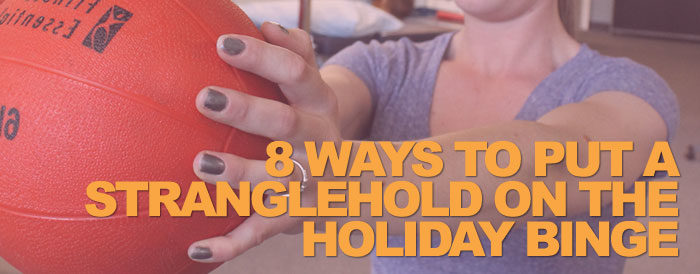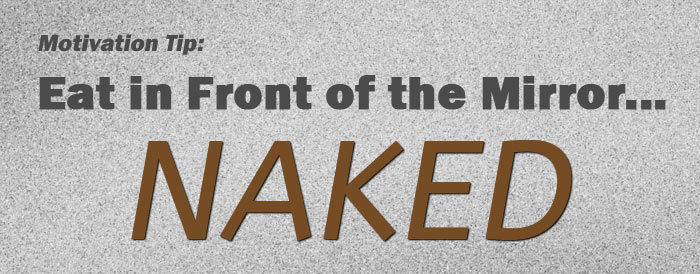Newmarket Physiotherapy
Overcoming Repetitive Ankle Injuries
A common injury for people involved in sports such as soccer, tennis, squash, or running is an ankle sprain. Many athletes and weekend warriors alike have experienced this injury, often multiple times, and may rely on using a brace for support to prevent re-injury or be forced to cut back on their participation due to recurring injury. It is possible to minimize the recurrence rate of this injury by seeing a qualified physiotherapist who can assess for and address the following limitations that are common in people with repetitive ankle injuries.
Some people who have had a long history of ankle injury have range of motion limitations. What can happen is the ankle swells following the sprain, and it gradually recovers, but the scar tissue that forms to rebuild the injured tissue does not get adequately stretched. This is how a stiff ankle can develop, and playing sports with this movement loss can lead to another injury quickly. A physiotherapist can identify these limitations and prescribe the proper stretches to recover as much mobility as possible.
Secondly, following the recovery from an acute (within 6 weeks of injury) ankle sprain there might not be any residual pain, but often there is a lingering weakness. Because the ankle feels free of pain the athlete is compelled to return to their sport, neglecting the strength deficits that are present. Depending on the sport, this might manifest as decreased endurance, overall strength, or explosive power such as in jumping sports. This can be remedied by regularly performing the appropriate exercises specific to your sport, exercises which can be determined by a physiotherapist.
A hidden impairment that an athlete may not notice after an ankle injury is decreased proprioception. This refers to the “position sense” of your joints and ligaments, similar in a way to other senses such as vision and smell. There are sensors embedded in these tissues that give the body feedback about where it is in physical space, and we rely on this sense to maintain good balance and stability during weight-bearing activity. After an ankle sprain, we often lose some of this sense, but it can be readily retrained much like muscle strength can. Specific balance exercises can be done to regain this sense, with progressions to sport-specific activity.
Building on that last point, before returning to your activity is considered, an athlete should be able to perform the necessary tasks involved in the activity. For example, a soccer player should be able to sprint, change directions quickly, kick, and dribble a ball. Often the speed at which these activities can be done following an ankle injury is much less than in normal conditions. Agility exercises and plyometrics, which are a type of exercise involving explosive movements such as jumps and sprints, are essential here. Regaining these skills is crucial to minimize the risk of long-term ankle injury recurrences.
To summarize, if you have had trouble with repetitive ankle injuries, you should consider seeing a physiotherapist who will assess to see if any impairments discussed above are present and design the optimal program for you to address them. Frequently the solution to the problem is relatively simple; it just takes some diligence to stick with the program to see results. Instead of worrying about your ankle every time you return to activity, wouldn’t it be nice to pivot, jump, sprint or whatever you do with confidence? You can make that a reality following an individualized physiotherapy regimen to help with your recovery, so you can get you back in the game as quickly and safely as possible.
The McKenzie Method – Mechanical Diagnosis & Therapy (MDT)
If you’ve ever had joint pain, this situation may be familiar to you: every family member, friend, and coworker has the time-honoured “magic solution” to get you better. Whether it’s heat, medication, meditation, or dousing yourself in honey, everyone has a suggestion. One you may have heard about is doing “McKenzie exercises” to recover. What are these exercises? Are they effective? How does it work?
“Mechanical Diagnosis & Therapy” or MDT
Also known as Mechanical Diagnosis & Therapy (MDT), the McKenzie Method is a comprehensive assessment system for orthopedic conditions such as back pain or shoulder pain, and is more than just a series of exercises. It allows the assessor to reliably classify you into different subgroups so that the right treatment can be applied. Practitioners need to understand you and your condition before they can hope to begin any treatment. It’s just like taking your car into the mechanic when something is malfunctioning – a good mechanic will take the time to ask you what the problem is (what are the symptoms?), and then will run tests to determine the source of the problem (does it hurt if you move that way?). You can’t expect the repairs to be made immediately – careful diagnosis is required first.
The McKenzie Method system was developed by New Zealand physiotherapist Robin McKenzie in the 1950s and 60s. One day he had a patient with back pain radiating down to his foot come in and he told him to go lie down on an unoccupied bed. Little did Robin know, the top half of the bed was at an angle, so the patient laid face-down on the bed with his back in maximum extension (like the cobra position in yoga). At the time the conventional wisdom was this was a terrible position for back pain. However, when Robin asked the patient how he was doing, he remarked that the leg pain had disappeared. This was so contrary to all his teachings that it inspired him to begin experimenting with different postures and movements and making careful observations with his patients. Patterns began to emerge, and he realized that these patterns could apply to all joints of the body.
McKenzie Method Today
Today the McKenzie Method is practiced globally by rehabilitation professionals of many backgrounds. Since its humble beginnings in New Zealand, it has been supported by numerous scientific publications around the world. Despite this, it is not a universally adopted system. Because the emphasis is first on understanding the problem at its root, which may take several sessions to achieve, it is at odds with the “treatment first” approach. Too often in rehabilitation the approach is to treat the symptoms with modalities such as heat or electrical stimulation, as opposed to getting an understanding of the cause. Fortunately, when the cause is identified using MDT, treatment can be very effective.
The majority of musculoskeletal problems are mechanical in nature – they are affected by movement. Mechanical problems require mechanical solutions, and often it is simply a matter of finding the right direction and force to move into. For example, a person with knee pain might respond to repeated knee straightening movements and have less pain and improved squatting mechanics as a result. If the right movement is applied regularly and aggravating factors are avoided, then rapid improvement is seen, often in a matter of days. Most people can treat themselves once they know what to do – patient independence is one of the central philosophies of MDT. This saves time and eliminates the need for long courses of treatment with many visits. Additionally, you will be shown how to prevent future episodes from occurring, and how to self-treat if the pain does happen to return.
So, the next time that shoulder starts to ache or your knee starts to lock up, instead of using the old family remedies, try looking up a certified McKenzie practitioner. The solution to your problem may be simpler than you think. York Rehab’s Newmarket Physiotherapy clinic has the most therapists certified in McKenzie treatment in Ontario.
Benefits of Chair Yoga
Yoga can be intimidating because there’s a misguided notion that you need an advanced level of strength and flexibility. And although possessing an advanced level of each will make a yoga session easier, a great workout is always achieved because yoga pushes your own limits no matter what your capability. Our Newmarket physiotherapy clinic has a Fitness Studio where we’ve been hosting yoga classes for several years. We think yoga is wonderful for your health, wellness, recovery and spirit. Yoga really is magical. From time to time we host a Chair Yoga session in order to encourage people to come out and experience Yoga – we feel if you try it once, you’ll be hooked.
So why the chair? Here are some benefits of Chair Yoga:
Balance & Support. We want to reduce the intimidation factor in order to get someone to come and experience yoga first hand. The chair adds an element to a person’s confidence knowing that it can be used as a prop to aid with balance and support. Poses that require a one-legged stance are much easier when you have something to hold on to and it allows you to develop competency in the particular position until you are comfortable enough to let go.
Building Strength & Stamina. Many are fooled into thinking that yoga is easy, it’s just a bunch of easy poses while you are sitting or lying down. And while sitting and lying are definitely part of the practice, the deliberate and controlled movement that is required from each pose will often engage muscles not normally used making yoga a great workout. This results in developing greater strength, stamina, flexibility, and balance. And this happens regardless of how good you are at yoga – as long as you challenge YOUR limits you will experience results.
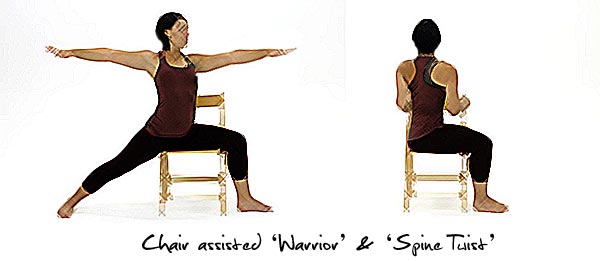
A chair to assist with something like a “spine twist” or a “warrior pose” can safely get you into slightly more challenging poses sooner allowing you to reap the rewards quicker.
Get into Activity Sooner. When recovering from an injury, especially if the injured area is in your lower body, mobility (and confidence) may be limited. A chair provides the support that allows you to begin introducing exercise/activity back into your life. The opportunity to sit while engaging in activity can reduce any discomfort you might feel while standing if you are recovering from an injury.
If you’d like to know when the Fitness Studio at our Newmarket physiotherapy clinic will hold its next chair yoga session give us a call – 289.796.1155.
8 Ways to Stranglehold the Holiday Binge
Thanksgiving is a wonderful holiday. It means spending time with family, reconnecting with loved ones, remembering the blessings in life that we’ve been gifted, and eating – lots and lots of eating for the occasion and continuing onwards for the next 3 months. Thanksgiving is like the kick-off to the holiday season socializing bonanza that ends in the New Year – that unrelenting stretch of party after party with seemingly unlimited access to food and drink. The bloated social calendar means lots of alcohol, finger foods, big meals and desserts which add up to a thicker waistline, a plumper rear-end and inevitably tighter fitting clothes. These harsh realities often mean stepping up a size or two on your next shopping excursion or remain in denial and battle with the bulges and tight-fit discomfort. Although the risk of that extra 5 to 10lbs is coming, and possibly tacked on to the gains you never managed to shed from last year’s stretch, there IS something you can do to avoid the gains. Here are 8 ways to plan ahead to counter the bingeing.
1. Serve Yourself from a Smaller Sized Plate. A smaller plate means less surface area to fill with all the yumminess in front of you. If you don’t have enough willpower to control your portions, the smaller real estate will provide adequate support.
2. Learn About the Number of Calories You’ll Be Around. If you know how many calories there are in some of the types of foods and snacks you’ll be offered, you may think twice about how you choose to eat. And be aware of the calories that are often overlooked – they like to hide in more than just dessert. For example, you may know that a bottle of Heineken has almost 150 calories but did you know the count for a Rum & Coke (143 cal), Cosmo (218 cal), or a Long Island Ice Tea (218 cal). Mixed drinks often come with a high caloric count because of the sugar-rich chasers so consider an “on the rocks” serving or chasing with just water (or at least dilute the sugary chaser). Also, follow up each drink with a glass of water – it will likely fill you up faster and reduce the overall amount of alcohol you throw back.
3. Dish out Greens and Veggies First! By starting to fill your plate with greens first, you leave less room for everything else.
4. Skip the Second Serving. After you eat, take your plate to the sink. If you leave it in front of you while you chat, it’s only a matter of time before someone will pass by asking if you’d like more or you may feel the need to reward yourself with seconds after enduring that long and boring story about that “whatever it is” delivered by the person sitting next to you. And although highly unlikely, if you have some lingering hunger pains, don’t worry because dessert is just around the corner.
5. Don’t Arrive Starving. It’s a proven fact that you should NOT go grocery shopping when you’re hungry because you’ll overspend. If you’re heading to a get together on an empty stomach, it’s a guaranteed recipe for over-eating. So maintain your regular eating routine before the big family dinner – have a generous lunch and even grab an afternoon snack before the “big eat”.
6. Maintain your exercise routine. Just because the holidays are here it doesn’t mean you need to take a break from exercise. If your normal routine is to exercise in the evening, change to a morning workout if your social calendar is going to be filled with after-work get-togethers.
7. Allow yourself some leeway for a missed workout or two. Just because you miss one or two workouts, it doesn’t mean it’s all falling apart and you should just give up and stop. Quickly forgive yourself for the missed session(s) and simply continue – tomorrow is always a new day.
8. Start Your New Year’s Fitness Resolution Before the Holidays. Instead of waiting until the New Year to begin your fitness goals, start in October. Beginning a new exercise routine before the “socializing stretch” is a sure fire way to acquire restraint. If you’re feeling good about yourself after losing a couple of pounds, you’ll be less likely to indulge because you’ll want to hold on to your healthy-living momentum.
If you plan ahead and fill yourself with the right information you’ll be able to manage your temptations head instead of letting them get out of hand. And remember the simplest option is always restraint; eating less isn’t a punishment, it’s a gift to you. Wouldn’t it be awesome to get exit the holiday stretch the same way you came into it. Best of luck!
Motivating Yourself to Exercise
You are looking to improve your overall health and know that regular exercise can help with that. So you sign up for a gym membership and have the class schedule on your fridge. But since taking the initial tour of the gym, you haven’t gone back. You just aren’t motivated to exercise. Don’t worry, you are not alone.
Finding the motivation to exercise can be tough, especially if you don’t like exercising. Here are some tips to help find your motivation:
Pack Your Gym Bag – Pack everything you need the night before and place your bag by the front door. Prepacking your bag means you don’t have to decide in the morning whether to exercise or not. Since your bag is packed you have no excuse not to exercise or talk yourself out of going.
Schedule Your Workouts – you put everything else in your calendar why not your workout? Plan your workouts a week ahead so that the time becomes blocked in your calendar. Consider these appointments sacred “me time” and try not to cancel them for other appointments.
Get a Workout Partner – when you know you are meeting someone for a workout, you are more likely to show up because you don’t want to let them down. Having a workout partner can motivate you to put more effort into training because someone is pushing you to do more.
Try Something Completely New – doing a brand new activity will force you to be fully engaged and help keep you motivated to exercise. Whether it’s yoga, fencing, rock climbing, or something else, having an instructor guiding you can make it seem more like a learning experience instead of exercise.
Leverage Your Lifestyle – try combining your workout with an established aspect of your life. Have kids? Go for family bike rides or help coach the kid’s sports team. Have a dog? Explore Thornton Bales Conservation Area or George Richardson Park for a scenic hike or go rollerblading with your pooch. Live in a condo or apartment? Try taking the stairs instead of the elevator down to your car in the morning.
Sign-Up for a Competition – whether it is a 5k run, climbing the CN Tower or participating in a Zumba-thon, the pending event date will help keep you motivated to exercise. When you know you have a reason to train, you are more likely to make yourself exercise so that you can finish the competition.
Find an Activity You Enjoy – when we say “activity” we mean something that will allow you to at least break a sweat (so scrap-booking doesn’t qualify). It’s never too late to learn a new sport – there are many adult leagues not only for intermediate and advanced participants but also for beginners. You can learn to play soccer or hockey. Or explore running or indoor rock climbing. If you find something you enjoy, it’ll be easier to lace up your shoes and get going.
Maintaining your motivation to exercise is sometimes challenging and may not always be related to your mind set. If you want to maintain a steady schedule of activity but find it hard due to recurring pain, it might be a good idea to see a physiotherapist.

